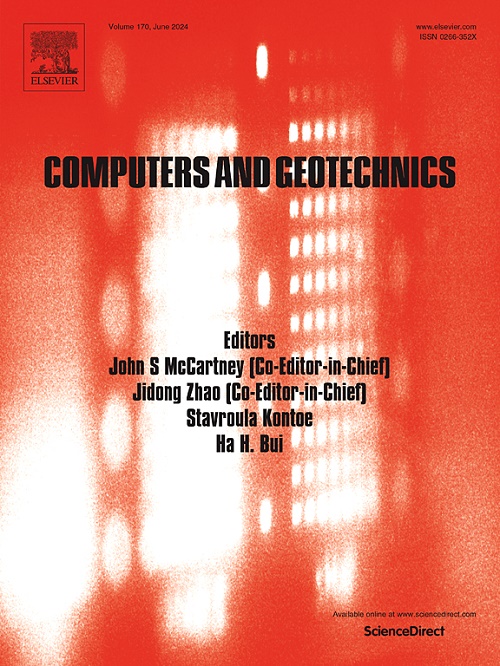Probabilistic characterization of inherent and epistemic geotechnical uncertainty in soil constitutive models using polynomial chaos expansion and monotonic drained triaxial tests
IF 6.2
1区 工程技术
Q1 COMPUTER SCIENCE, INTERDISCIPLINARY APPLICATIONS
引用次数: 0
Abstract
This study proposes a probabilistic, uncertainty-informed framework for calibrating advanced soil constitutive models (SCMs), particularly, advanced critical state-based models, to accurately capture uncertainty in soil behavior in geotechnical applications. The proposed framework incorporates Polynomial Chaos Expansion (PCE) metamodels to optimize sensitivity analysis (SA) and enable Bayesian updating of SCM parameters, ensuring precise calibration that addresses inherent and epistemic uncertainties. Additionally, Random Forest (RF) analysis is employed to validate initial statistical assumptions and parameter trends during SA and enhance the robustness in the calibration process. Monotonic drained triaxial tests are used within this framework to calibrate the SANISAND model, an advanced critical state-based SCM for sand, with a focus on Nevada Sand soil due to its significance in geotechnical engineering. The framework estimates parameters’ joint probability density functions (PDFs) from experimental data, providing probabilistic insights into model responses under varying confining pressures and relative densities. By reducing computational demands and integrating uncertainty quantification, this approach offers an efficient and accurate calibration process, improving SCM predictive capability and reliability for use in finite element (FE) analyses. This study demonstrates the framework’s application and validation to Nevada Sand and proposes PDFs with correlation coefficients for the SANISAND model, accelerating its integration in posterior stochastic geotechnical system-level modeling.
利用多项式混沌展开和单调排水三轴试验对土本构模型中固有和认知岩土不确定性的概率表征
本研究提出了一个概率的、不确定性的框架,用于校准先进的土壤本构模型(scm),特别是先进的基于临界状态的模型,以准确地捕捉岩土工程应用中土壤行为的不确定性。该框架采用多项式混沌展开(PCE)元模型来优化灵敏度分析(SA),并实现SCM参数的贝叶斯更新,确保精确校准,解决固有的和认知的不确定性。此外,随机森林(RF)分析用于验证SA过程中的初始统计假设和参数趋势,并增强校准过程中的稳健性。在此框架内使用单调排水三轴试验来校准SANISAND模型,SANISAND模型是一种先进的基于临界状态的砂土SCM,由于其在岩土工程中的重要性,因此重点关注内华达砂土。该框架根据实验数据估计参数的联合概率密度函数(pdf),提供了在不同围压和相对密度下模型响应的概率见解。通过减少计算需求和整合不确定度量化,该方法提供了高效准确的校准过程,提高了SCM在有限元分析中的预测能力和可靠性。本研究展示了该框架在内华达州沙地的应用和验证,并为SANISAND模型提出了具有相关系数的pdf文件,加速了其在后验随机岩土系统级建模中的集成。
本文章由计算机程序翻译,如有差异,请以英文原文为准。
求助全文
约1分钟内获得全文
求助全文
来源期刊

Computers and Geotechnics
地学-地球科学综合
CiteScore
9.10
自引率
15.10%
发文量
438
审稿时长
45 days
期刊介绍:
The use of computers is firmly established in geotechnical engineering and continues to grow rapidly in both engineering practice and academe. The development of advanced numerical techniques and constitutive modeling, in conjunction with rapid developments in computer hardware, enables problems to be tackled that were unthinkable even a few years ago. Computers and Geotechnics provides an up-to-date reference for engineers and researchers engaged in computer aided analysis and research in geotechnical engineering. The journal is intended for an expeditious dissemination of advanced computer applications across a broad range of geotechnical topics. Contributions on advances in numerical algorithms, computer implementation of new constitutive models and probabilistic methods are especially encouraged.
 求助内容:
求助内容: 应助结果提醒方式:
应助结果提醒方式:


